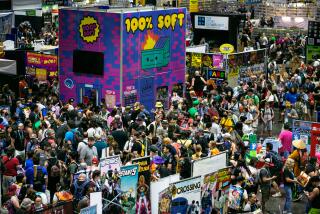Convention Center Cost Estimate Flaws Cited
- Share via
A major discrepancy in the amount of steel and concrete needed for San Diego’s waterfront convention center accounts for most of the projected $20-million budget increase for construction of the center, a special mayoral task force was told Tuesday.
The disclosure that 30% more concrete and more than double the amount of steel originally estimated may be needed to build the convention center was made by San Diego Unified Port District Commissioner William Rick. He also told the task force that those additional expenses, combined with other factors, could push the “open-the-doors cost” of the center, once set at $95 million, to nearly $160 million. In addition, any attempt to substantially reduce construction costs probably would require design changes that could delay the center’s completion by up to two years, Rick emphasized.
Faced with those stark factors, task force member Paul Buss summarized the attitude that pervaded the panel’s 90-minute City Hall meeting by posing one simple question: “What can we do?”
The answer to that question, however, probably will not be known until after the task force spends the next month trying to figure out why the construction bids unveiled last week by the San Diego Unified Port District were so much higher than expected.
“We’ve got a lot of questions today but not many answers,” said acting Mayor Ed Struiksma, who said he established the task force to help explain to the public “why we are where we are.”
The task force, which consists of local business and civic leaders, including several leading architects and construction experts, was formed after the bids of six large construction firms to build the 1.4-million-square-foot structure came in more than $20 million over the Port District’s $101.5-million budget.
The lowest base bid was submitted by Continental Heller Corp. of Sacramento, which bid $123.9 million, or about $22.4 million more than the port’s projected budget. The other five bids ranged from $124.9 million to $133.7 million.
The Port District must act on those bids by May 18, leaving the task force little time to answer what might be termed the $22-million--or $65-million--question, depending on which figures are used.
Much of the answer apparently can be found in the fact that design engineers and city building inspection consultants produced dramatically different estimates on the amount of steel and concrete needed to build the convention center, Rick explained.
Last fall, the design experts, hired by project architect Ward Deems, estimated that 98,000 cubic yards of concrete and 8,400 tons of reinforcing steel would be required. However, Rick told the task force that Deems now says that 129,000 cubic yards of concrete and 17,000 tons of steel--32% and 102% increases, respectively--will be needed to satisfy city safety requirements. The additional steel and concrete, Rick said, would increase costs by about $18 million.
“From a layman’s perspective, I’ve got a question how those numbers can be that far apart,” Struiksma said.
Rick responded: “That’s an excellent, excellent question. But I can’t answer that. I don’t know.”
Indeed, one of the questions that the task force hopes to answer at its meeting next week is whether the design experts originally underestimated the amount of steel and concrete needed, or whether the city building officials have overestimated the requirements.
The wide discrepancy in the estimates, Rick said, may stem from differences in how building codes are interpreted and in design changes made after the original estimates.
“The (city’s) building checking program . . . is accomplished through interpretations of the Uniform Building Code, which changes from year to year,” Rick said. “And the (city) plan checkers’ interpretations (differ from) design engineers’ interpretations. Thinking people, reasoning people, can come to those differences of opinion.
“Bear in mind that positions are a bit different. The design professional going in there . . . knows he’s got some budget limits. He also has time limits which govern his behavior. The plan checker, on the other hand, is representing the city as the operating agency and (on) the primary health and safety responsibilities written into its code. So they’re standing on two different perspectives on the same subject.”
Most of the task force members agreed with lawyer John Davies, former chairman of the city Planning Commission, who said that the panel should not “get bogged down in pointing fingers” over the projected increase, but should identify alternatives on how the convention center could be built as inexpensively and rapidly as possible.
Struiksma pointed out that one of the task force’s principal functions will be to “report to the people why we ended up with an extra $20 million to $25 million, whether it’s steel or concrete or whatever.”
If the center’s design is changed in a cost-cutting move, the Port District would have to solicit new bids--a process that could delay construction by between four months and two years, depending on the magnitude of the alterations, Rick said.
In addition, Buss, president of Buss Silvers Hughes & Associates, a local architectural and engineering firm, noted that solicitation of new bids could result in even higher construction cost estimates.
“If you go back out to bid, it’s going to be worse, not better,” Buss said.
More to Read
Sign up for Essential California
The most important California stories and recommendations in your inbox every morning.
You may occasionally receive promotional content from the Los Angeles Times.













